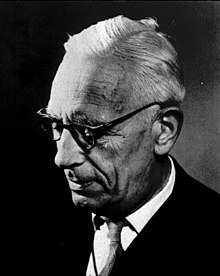|
Jaap Kunst
Jaap Kunst (12 August 1891 – 7 December 1960) was a Dutch musicologist. He is credited with coining the term "ethnomusicology" as a more accurate name for the field then known as comparative musicology. Kunst studied the folk music of the Netherlands and of Indonesia. His published work totals more than 70 texts.[1] Early lifeKunst was born on 12 August 1891 in Groningen. Both of his parents were musicians, and his father was a music-school teacher. He began to study the violin at only 5 years old, and continued to play the instrument throughout his life.[2][3] Kunst was drawn toward folk music as a result of vacations to the island of Terschelling.[3] Kunst decided to pursue a career in law. While studying law, Kunst published the results of his first musical research.[4] Kunst earned a degree in law from the University of Groningen in 1917. and pursued a career in banking and law for the next two years.[2] However, he soon grew tired of this work.[4] Work in IndonesiaIn 1919, Kunst set out on a tour of the Dutch East Indies with a recently-formed musical trio. This group performed 95 times throughout Indonesia.[2] Kunst heard a gamelan ensemble for the first time at the Paku Alaman palace in Yogyakarta. Impressed, he decided to remain in Java to study Indonesian music, while the other members of his trio departed.[2] Taking a job as an official in the colonial government, Kunst remained in Java for fifteen years.[4] He married Kathy van Wely in 1921; she became a partner in Kunst's work.[2][4] Kunst was the first person to record gamelan music on wax cylinders. He amassed an archive of photographs, recordings, and instruments of Indonesian music.[2][4] He ceded much of his collection to the Koninklijk Bataviaasch Genootschap van Kunsten en Wetenschappen (now the National Museum of Indonesia).[2] Later activitiesIn 1934, Kunst returned to the Netherlands, and he became the curator of Amsterdam's Colonial Museum (now the Royal Tropical Institute) in 1936.[2] Later, he became a lecturer at the University of Amsterdam.[4] Kunst first used the term "ethno-musicology" in his 1950 publication Musicologica. He stated:
Ethnomusicology (with no hyphen) quickly replaced comparative musicology as the name of the field. This usage was influenced by the formation of the Society for Ethnomusicology in 1955. In 1956, Kunst released a bestselling album of folk songs, on Folkways Records, entitled Living Folksongs and Dance-Tunes from the Netherlands.[6] Kunst died in 1960 of throat cancer in Amsterdam.[4] IdeasKunst believed musical study must take into account the cultural context of its creation. In his view, musicology was incomplete without ethnographic elements. Contrary to mainstream European scholarship at the time, Kunst believed that music from other continents was no less sophisticated than the music of Europe, and he often argued this point against others.[4] LegacySince 1965, the Society for Ethnomusicology has offered an annual prize named after Kunst. Until 2018, the prize honored the most significant ethnomusicological article of the previous year by a society member. From 2019 onward, only researchers in their first 10 years of scholarship are eligible for the prize.[7] Writings
References
External links
|
||||||||||||||
